Have you ever found yourself craving a steak that’s packed with flavor but doesn’t break the bank or require hours in the kitchen? Enter skirt steak—your new secret weapon for creating restaurant-quality meals right at home. Whether you’re firing up the grill for a summer barbecue or whipping up a quick weeknight dinner, this cut of beef is a game-changer. Its rich, beefy taste and tender, juicy texture make it perfect for tacos, stir-fries, or just savoring on its own. If you’re ready to impress without the stress, you’re in for a delicious surprise!
List Of Contents
What Is Skirt Steak?
Skirt steak is a long, thin cut of beef taken from the diaphragm muscles of the cow. It belongs to the primal plate section, located between the chest and the abdomen. Despite its relatively tough texture compared to other cuts, its intense beefy flavor makes it a favorite for grilling and marinating. Check out more recipes here.
- Skirt steak is commonly associated with cuisines like Mexican, where it’s a key ingredient in fajitas, and South American, where it features prominently in asado (barbecue).
- Due to its thin and narrow shape, it cooks quickly, making it an ideal choice for fast, high-heat cooking methods.
The Unique Qualities of Skirt Steak
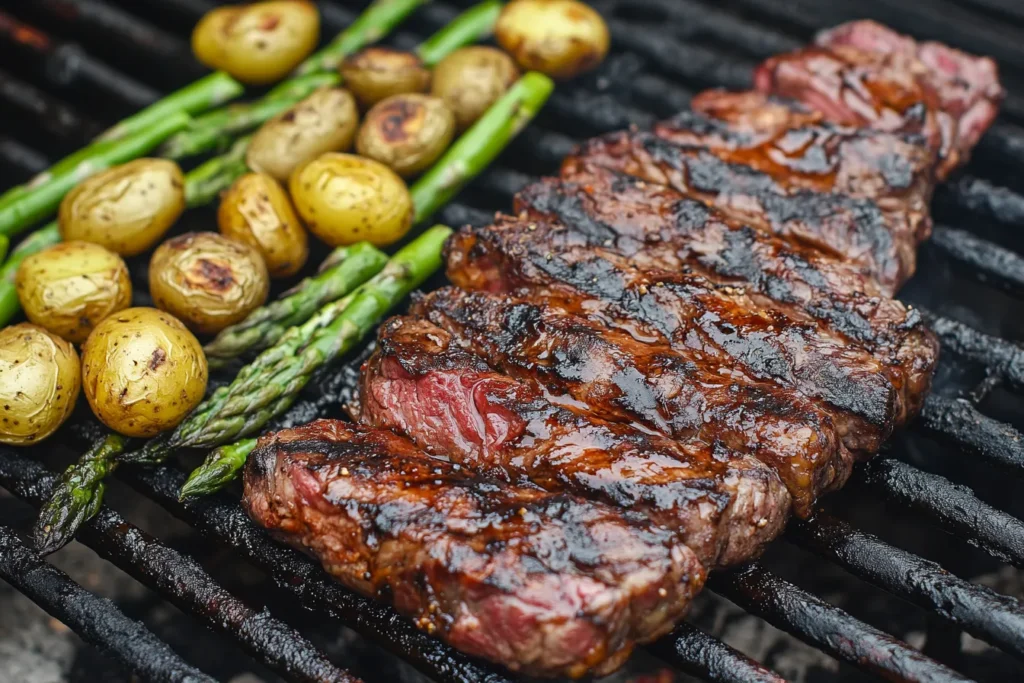
Texture, Flavor Profile, and Appearance
What sets skirt steak apart from other cuts of beef is its distinct characteristics:
- Texture: Skirt steak is coarse and has a prominent grain, which gives it a slightly chewy consistency. This makes it ideal for marinating, as the open grain allows flavors to penetrate deeply.
- Flavor Profile: Known for its rich and intensely beefy flavor, skirt steak holds its own in any dish without being overpowered by marinades or sauces.
- Appearance: A raw piece of skirt steak is long, flat, and ribbon-like, with visible marbling that enhances its flavor and tenderness when cooked properly.
Skirt steak is a cut that balances both character and versatility, making it a top pick for recipes that demand bold flavors. Check out more recipes here.
Anatomy of Skirt Steak
Where Does Skirt Steak Come From?
Skirt steak is derived from the diaphragm muscle of the cow, which runs along the ribcage. This area provides two distinct types of skirt steak:
- Outer Skirt Steak:
- Comes from the outer side of the diaphragm.
- Known for being slightly more tender and thicker.
- Inner Skirt Steak:
- Found closer to the abdominal cavity.
- A bit leaner and thinner, making it less tender than the outer skirt.
Both cuts share the same characteristic flavor but differ in their cooking applications and level of tenderness. Check out more recipes here.
Difference Between Inner and Outer Skirt Steak
The two types of skirt steak can often be used interchangeably, but their subtle differences are worth noting:
- Inner Skirt Steak:
- Best for quick cooking methods like stir-frying or fajitas.
- Benefits from marination to enhance tenderness.
- Outer Skirt Steak:
- Preferred for grilling or searing due to its slightly more robust texture and flavor.
- Retains moisture and tenderness better under high heat.
History and Culinary Significance
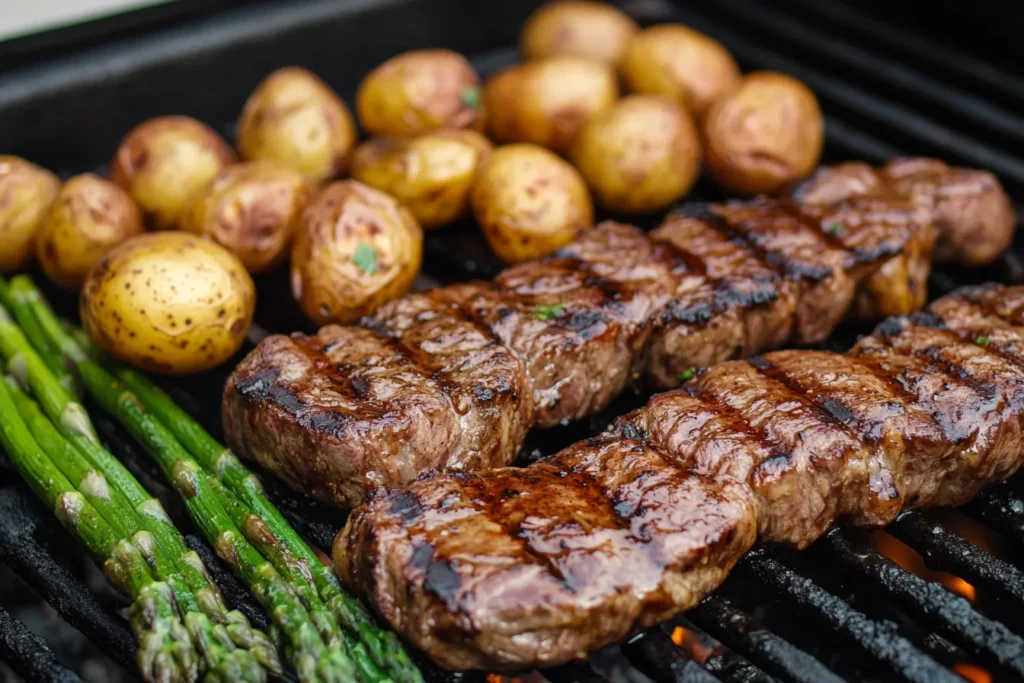
Origins of Skirt Steak as a Cut
Historically, skirt steak was considered a “butcher’s cut,” often kept for personal use rather than sold commercially. Its popularity grew in cuisines that emphasized affordable, flavorful cuts of meat.
- Mexican Cuisine: Skirt steak gained fame as the star ingredient in fajitas, where it’s cooked with peppers and onions for a sizzling dish.
- South American Cuisine: Countries like Argentina and Brazil introduced skirt steak into their asado traditions, grilling it over open flames and serving it with chimichurri.
Popularity in Modern Cuisine
Today, skirt steak has transcended its humble origins to become a staple in high-end and casual dining alike. Its affordable price compared to premium cuts like ribeye, combined with its bold flavor, has made it a favorite among chefs and food enthusiasts.
- Restaurants often feature it in global fusion dishes, from Korean BBQ to steak tacos.
- Home cooks appreciate its quick cooking time and adaptability to a wide range of seasonings and sides.
Nutritional Profile of Skirt Steak
Macronutrients in Skirt Steak
When it comes to nutrition, skirt steak provides a substantial dose of protein, making it a great choice for those looking to incorporate lean meats into their diet.
- Calories: A 3-ounce serving contains approximately 200 calories.
- Protein: Skirt steak delivers around 23 grams of protein per serving.
- Fat: It contains about 10 grams of fat, with a balance of saturated and unsaturated fats.
Vitamins and Minerals
Beyond macronutrients, skirt steak is packed with essential vitamins and minerals:
- Iron: Supports oxygen transport in the blood.
- Zinc: Boosts immune function and aids in healing.
- B Vitamins: Includes niacin, riboflavin, and B12, all vital for energy production and neurological health.
Its nutrient density makes skirt steak an excellent option for individuals looking to fuel their body with high-quality, bioavailable nutrients. Check out more recipes here.
Cooking and Preparation Method
Preparing Skirt Steak for Cooking
Proper preparation is crucial for getting the most out of skirt steak. Its unique texture and grain make a few key steps essential before cooking.
Trimming and Cleaning Skirt Steak
Skirt steak often comes with a membrane or silver skin on one side, which needs to be removed for optimal tenderness.
- Use a sharp knife to carefully trim away the tough outer membrane.
- Remove any excess fat, as it can create flare-ups during grilling but leave enough for added flavor.
- Pat the steak dry with a paper towel to ensure a proper sear during cooking.
These steps create a clean canvas for marinades or rubs, allowing them to adhere better. Check out more recipes here.
Marinating Skirt Steak
Due to its coarse grain, skirt steak benefits immensely from marination. A good marinade not only tenderizes the meat but also infuses it with flavor.
Key ingredients for a perfect marinade:
- Acidic Components: Lime juice, vinegar, or wine help break down muscle fibers, making the steak tender.
- Oil: Olive or avocado oil helps the flavors penetrate deeper.
- Aromatics and Spices: Garlic, herbs, soy sauce, and chili powder add complexity to the taste.
Let the steak marinate for at least 30 minutes, but ideally 4–6 hours for the best results.
Cooking Techniques
Once prepped, skirt steak is best cooked quickly over high heat. Its thin profile means it can go from perfectly cooked to overdone in minutes. Below are some of the most popular methods to cook skirt steak.
Grilling Skirt Steak
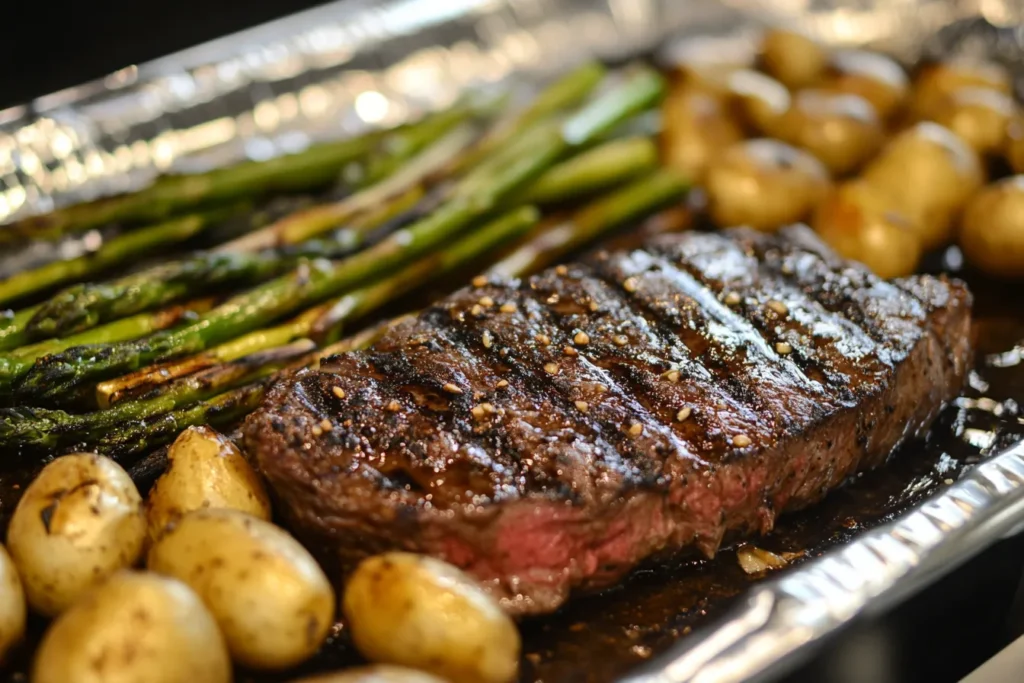
Grilling is the gold standard for cooking skirt steak, as the open flame enhances its natural smoky flavor.
- Preheat the grill to high heat (450–500°F).
- Place the steak directly over the flames and cook for 2–3 minutes per side for medium-rare.
- Let the steak rest for 5 minutes before slicing.
Pro Tip: Avoid flipping the steak too often to achieve a perfect char.
Pan-Seared Skirt Steak
If you don’t have a grill, a cast-iron skillet can deliver an equally delicious result.
- Heat the skillet over high heat and add a high-smoke-point oil (like canola or avocado oil).
- Sear the steak for 2–3 minutes on each side.
- Add butter, garlic, and herbs (like thyme or rosemary) in the final minute to baste the steak.
This method creates a crusty, caramelized exterior that pairs perfectly with the steak’s juicy interior.
Sous vide is an excellent option for ensuring even cooking and maximum tenderness.
- Season the steak and vacuum-seal it in a bag.
- Cook it in a water bath at 130°F (for medium-rare) for 1–2 hours.
- Finish with a quick sear on a hot grill or skillet to develop a crispy crust.
Sous vide guarantees consistent results, even for novice cooks.
Broiling in the oven is another effective option, especially when grilling isn’t feasible.
- Preheat the oven broiler to high.
- Place the steak on a broiler pan, about 4–6 inches from the heat source.
- Broil for 3–4 minutes per side, flipping once.
Broiling works well when cooking for a crowd, as it allows you to prepare multiple steaks simultaneously.
Tips for Cooking Skirt Steak
To achieve your desired level of doneness, follow these internal temperature recommendations:
- Rare: 125°F
- Medium-Rare: 135°F
- Medium: 145°F
- Well-Done: 160°F
Use a meat thermometer to avoid overcooking, as skirt steak toughens quickly if cooked past medium.
Slicing for Maximum Tenderness
One of the most important steps in serving skirt steak is how you slice it. Always cut against the grain to shorten the muscle fibers, resulting in a more tender bite.
- Identify the direction of the grain (the visible muscle lines running along the steak).
- Use a sharp knife to make thin slices perpendicular to the grain.
Proper slicing can make even the chewiest cuts melt in your mouth.
Skirt Steak in Recipes and Cuisine
Skirt steak’s bold flavor makes it a star ingredient in many global cuisines. Let’s explore its traditional and modern uses.
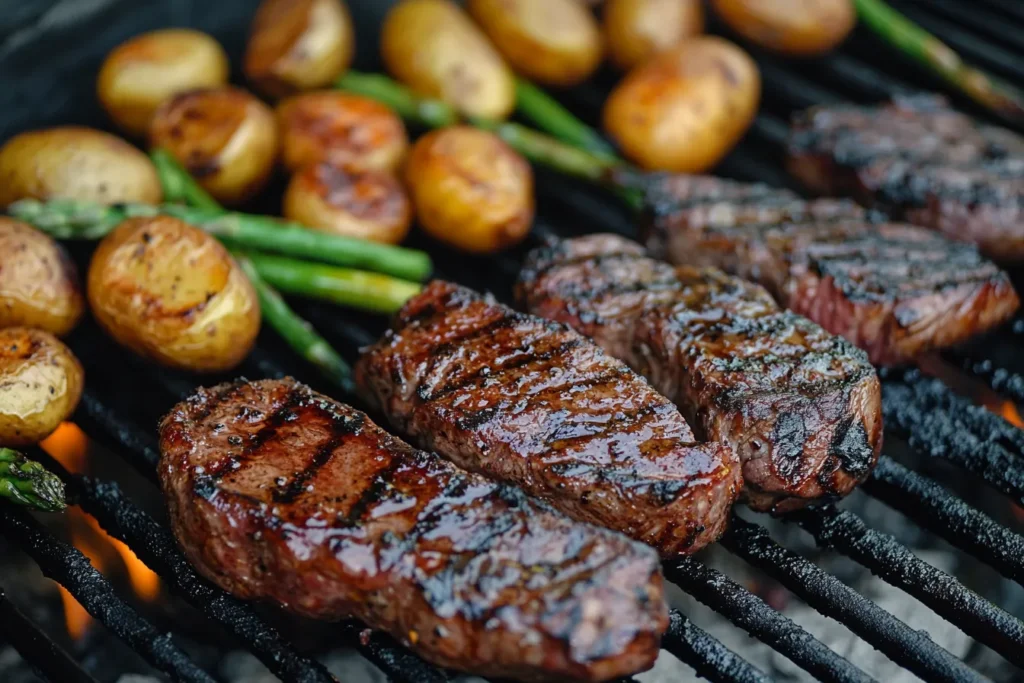
Mexican Cuisine: Skirt Steak in Fajitas
Skirt steak is synonymous with fajitas, a Tex-Mex classic.
- The steak is typically marinated with lime juice, garlic, and cumin before being grilled or seared.
- It’s served sizzling with sautéed onions and bell peppers, accompanied by tortillas, guacamole, and salsa.
This iconic dish highlights the steak’s natural flavor while complementing it with vibrant, fresh ingredients.
South American Influence: Asado and Beyond
In Argentina and Brazil, skirt steak shines in traditional barbecues known as asado.
- The steak is grilled over an open flame and served simply with chimichurri sauce.
- Its robust flavor pairs perfectly with the herbaceous and tangy notes of chimichurri.
This preparation celebrates the simplicity of cooking with fire and quality ingredients.
Skirt Steak in Contemporary Dishes
Fusion Recipes Featuring Skirt Steak
Modern chefs love using skirt steak in global fusion recipes. Some examples include:
- Korean-style bulgogi made with thinly sliced skirt steak.
- Mediterranean wraps with grilled steak, hummus, and tzatziki.
Fusion dishes allow chefs to push the boundaries of this versatile cut.
Skirt Steak in Salads and Wraps
For lighter fare, skirt steak is an excellent addition to salads and wraps:
- Add grilled slices to a bed of arugula, cherry tomatoes, and shaved Parmesan for a hearty steak salad.
- Wrap thin slices in whole-grain tortillas with fresh veggies and a tangy dressing for a quick and healthy lunch.
These creative uses highlight the steak’s versatility and adaptability.
Buying and Storing Skirt Steak
Selecting Quality Skirt Steak
When shopping for skirt steak, look for the following:
- Color: Bright red meat indicates freshness.
- Marbling: Fine streaks of fat enhance flavor and tenderness.
- Thickness: Opt for pieces that are uniform in thickness for even cooking.
Ask your butcher whether the steak is an inner or outer cut, as this can influence cooking methods.
Proper Storage Techniques
To maximize shelf life and prevent spoilage:
- Refrigeration: Store skirt steak in the coldest part of your fridge and use it within 3–5 days.
- Freezing: Wrap the steak tightly in plastic wrap or vacuum-seal it before freezing. It can be stored for up to 6 months.
Thaw frozen steak in the refrigerator overnight to preserve its texture and flavor.
Mexican Cuisine: Skirt Steak in Fajitas
Skirt steak is iconic in Mexican cuisine, especially as the foundation of fajitas. The origins of fajitas lie in the ranching culture of northern Mexico and Texas, where the vaqueros (cowboys) marinated this inexpensive cut to enhance its flavor and tenderness.
- Preparation involves a citrus-based marinade infused with garlic, cumin, and chili powder.
- After grilling, the steak is sliced and served sizzling alongside onions and bell peppers.
- Accompaniments like guacamole, sour cream, and salsa complete the meal.
This dish embodies the steak’s ability to soak up bold flavors and become the centerpiece of a meal.
South American Influence: Asado and Beyond
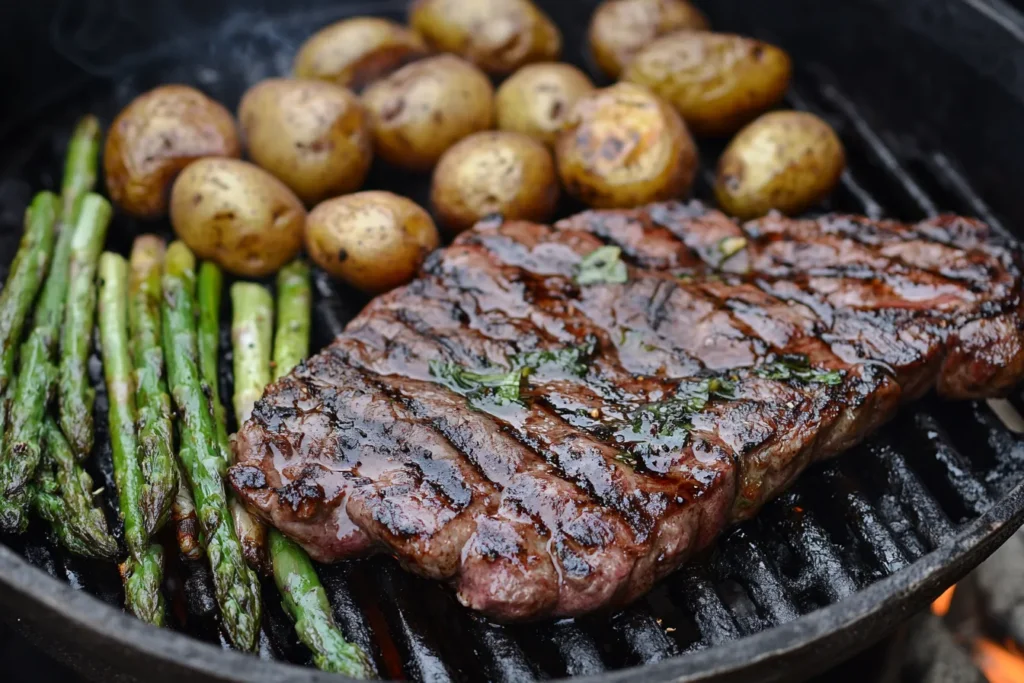
In South America, particularly Argentina and Brazil, skirt steak is a barbecue favorite. Known as “entraña” in Spanish, it plays a starring role in the traditional asado.
- The steak is seasoned simply with salt and grilled over parrillas (charcoal grills).
- Chimichurri, a vibrant sauce made from parsley, garlic, olive oil, and vinegar, is a must-have pairing.
- In Brazil, skirt steak is often served in churrasco-style barbecues alongside other meats, sausages, and grilled vegetables.
This minimalist approach emphasizes the steak’s natural flavor, making it a favorite among purists.
Skirt Steak in Contemporary Dishes
Fusion Recipes Featuring Skirt Steak
Chefs around the world have incorporated skirt steak into innovative fusion recipes.
- Asian Fusion: Skirt steak is thinly sliced for Korean bulgogi or served over soba noodles with sesame dressing.
- Mediterranean Wraps: It’s used as a filling in pita bread with roasted vegetables, tzatziki sauce, and feta cheese.
- Steak Tacos with a Twist: Skirt steak is paired with non-traditional toppings like mango salsa or wasabi crema for a fresh take.
These recipes demonstrate the steak’s versatility and adaptability to various flavor profiles.
Skirt Steak in Salads and Wraps
For those seeking healthier options, skirt steak shines in salads and wraps.
- Salads: Combine grilled skirt steak with mixed greens, avocado, cherry tomatoes, and balsamic vinaigrette for a nutrient-rich dish.
- Wraps: Use whole-grain tortillas filled with thinly sliced steak, fresh veggies, and hummus for a quick lunch.
These dishes showcase how skirt steak can balance rich flavor with lighter, nutritious ingredients.
Buying and Storing Skirt Steak
Selecting Quality Skirt Steak
When shopping for skirt steak, consider the following factors to ensure you’re getting the best cut:
- Color: The meat should be bright red, indicating freshness. Avoid cuts with a dull or grayish hue.
- Marbling: Look for visible streaks of fat running through the meat. These enhance flavor and tenderness.
- Thickness: Choose cuts that are evenly thick, as this helps ensure uniform cooking.
- Packaging: If buying pre-packaged steak, check for tightly sealed wrapping and no excess liquid, which can signal improper storage.
For the highest quality, purchse from a trusted butcher who can guide you on whether you’re getting inner or outer skirt steak.
Proper Storage Techniques
To maintain the freshness and flavor of your skirt steak, follow these storage tips:
- Refrigeration: Store raw skirt steak in the coldest part of your fridge, ideally in its original packaging. Use it within 3–5 days for the best quality.
- Freezing:
- Wrap the steak tightly in plastic wrap, then place it in a freezer-safe bag.
- For long-term storage, vacuum sealing is ideal. Properly stored, it can last up to 6 months in the freezer.
- Thawing: Defrost frozen skirt steak in the refrigerator overnight. Avoid thawing at room temperature, as this can promote bacterial growth.
Proper storage not only extends shelf life but also ensures the steak retains its signature flavor.
Alternatives and Comparisons
Skirt Steak vs. Flank Steak
Skirt steak is often compared to flank steak due to their similar appearance and cooking applications. However, there are notable differences between the two:
| Feature | Skirt Steak | Flank Steak |
|---|---|---|
| Location | Comes from the diaphragm muscle. | Comes from the lower abdominal muscles. |
| Texture | Coarser, with more prominent muscle fibers. | Slightly leaner and less grainy. |
| Flavor | Rich and intensely beefy. | Milder flavor compared to skirt steak. |
| Cooking Methods | Best for quick, high-heat cooking like grilling. | Suitable for grilling, broiling, or roasting. |
| Tenderness | Requires marination and slicing against the grain. | Slightly more tender, but still benefits from slicing against the grain. |
While they can be used interchangeably in recipes like fajitas or stir-fries, skirt steak’s robust flavor makes it a better choice when boldness is desired.
Other Cuts with Similar Profiles
If skirt steak is unavailable, consider these alternatives:
- Hanger Steak: Known as the “butcher’s steak,” hanger steak shares a similar flavor intensity but is slightly more tender.
- Flat Iron Steak: This cut is well-marbled and tender, making it a good substitute for recipes that call for marinating.
- Bavette Steak: Also known as flap meat, bavette has a looser grain and works well in similar dishes, particularly stir-fries and tacos.
Each of these cuts offers a unique twist on skirt steak’s characteristics, providing versatility in the kitchen.
FAQs
- What is skirt steak best used for?
Skirt steak is best for high-heat cooking methods like grilling, searing, or broiling, and is a staple in dishes like fajitas and stir-fries. - How long should I marinate skirt steak?
Ideally, marinate it for 4–6 hours, but even 30 minutes can enhance flavor and tenderness. - Can I cook skirt steak in the oven?
Yes, broiling is a great oven method for cooking skirt steak quickly and evenly. - How do I make skirt steak tender?
Marinate it with acidic ingredients, cook it to medium-rare, and slice it thinly against the grain. - What’s the difference between inner and outer skirt steak?
Outer skirt steak is thicker and more tender, while inner skirt steak is thinner and slightly chewier. - What temperature should I cook skirt steak to?
For medium-rare, aim for an internal temperature of 135°F. - Can I freeze cooked skirt steak?
Yes, cooked skirt steak can be frozen for up to 3 months in an airtight container. - Is skirt steak a lean cut?
While not as lean as flank steak, it contains moderate fat, which contributes to its rich flavor. - What are common seasonings for skirt steak?
Common seasonings include salt, pepper, garlic, cumin, chili powder, and citrus-based marinades. - How long should skirt steak rest after cooking?
Let it rest for 5–10 minutes to allow the juices to redistribute, ensuring a juicy steak.
